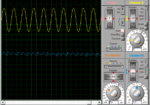nsypid
Junior Member level 3

The datasheet states that Vo= VccxfinxC1xR1.
I want to know what is the value of Vcc in my attached circuit diagram.
and also Fmax = I2/C1xVcc
What is the value of I2 here ?
What value of R1, C1 and C2 should i use if i want to measure up to 250 Hz input signal with that circuit ?
I want to know what is the value of Vcc in my attached circuit diagram.
and also Fmax = I2/C1xVcc
What is the value of I2 here ?
What value of R1, C1 and C2 should i use if i want to measure up to 250 Hz input signal with that circuit ?



